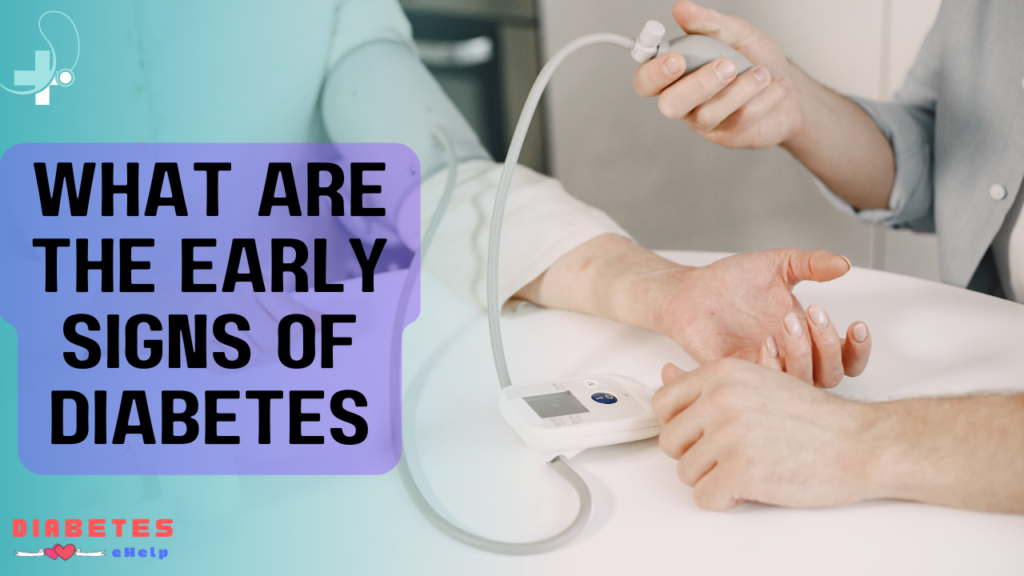Finding early signs of any disease is important because then they can treat it before it turns into the worst condition. Diabetes shows very mild signs and symptoms, especially when it’s turning into type 2 diabetes, and that’s why people know about it when it’s already caused most of the damage.
If people know what some specific early signs of diabetes are, they can go for a test if they notice these signs in their body. In this article, we are going to cover all the top early signs of diabetes that people see in their early stages of diabetes.

Why recognizing early diabetes is important
Recognizing early diabetes problems gives a person the chance to treat the problem in a better way and sooner. The right treatment for diseases in their early stages can reduce the risk of complications in the future.
If someone does not notice the early signs, they can give birth to any other diseases associated with diabetes, like heart disease, kidney disease, problems related to sex, stroke, nerve damage, and many more.
Many people even do not notice a sign of diabetes until it becomes worse, and then they put their lives in danger. Knowing the common signs of both types of diabetes not only keeps one person safe, but the person can also check if their loved ones are also seeing these common signs in their body or not.
Top early signs and symptoms of diabetes
These are some signs that you can see in both types of diabetic conditions, and they are very common in the early stages of diabetes.
1- Extreme hunger: Every person knows how much food they eat, usually regardless of whether they are hungry or not. In diabetes, sometimes people who do not eat much start eating more than normal, and they always feel hungry even after just eating. The food turns into glucose, cells do not get much insulin, and that is why a person does not feel the energy and always feels fatigued or hungry.
2- Peeing more: A normal human will pee four or seven times in one day, but a diabetic patient will do more than this. The body starts to make urine more in people with diabetes and takes the fluid from different parts of the body, which also makes the person more thirsty than normal.
3-Vision problem: The high sugar level in the blood damages the blood vessels of the eye, which makes the person’s vision unclear. The problem can start with one eye, and then it can affect both. Blurred vision can cause swelling, but it will reduce if the sugar level in the blood is reduced. This early sign can get worse after some time, and people can lose their whole vision sometimes.
4-Cuts heal slowly: High amounts of sugar in the blood start damaging the blood vessels and nerves of the body, which results in the damaged circulation of blood. The diabetic person will notice that their small wounds are taking months or weeks to heal properly, which can make their infection worse.
5-Pain in the body: Early signs of diabetes include pain in some specific areas of the body, like the feet or hands. People can also feel tingling or numbness suddenly. The reason for the pain is that your blood circulation is not going well, and the nerve has started being damaged, and the cause can be diabetes.
6-Dark skin patches: Dark skin patches can appear on the neck, armpits, or even in the groin. People can notice these changes if they do not have any skin problems or dark patches. These patches are soft and feel velvety. It is a type of acanthosis nigricans disease, which can come from diabetes.
7-Yeast infection: Yeast comes from places where there is a high amount of urine or sugar in the blood. It can grow in moist and warm places like the mouth, armpits, or genitals. The areas where yeast will grow can feel itchy, and the person can feel burning sometimes.
Conclusion:
If anyone experiences these early signs of diabetes, visit a doctor as soon as possible. Choose a doctor who is well experienced and has good information about diseases like diabetes or both types.
Treating diseases becomes easier and less stressful when we find them in their early stages. Take all the signs seriously, and tell these signs to your family and friends so they can also keep themselves safe from these untreatable diseases.
Recent Comments